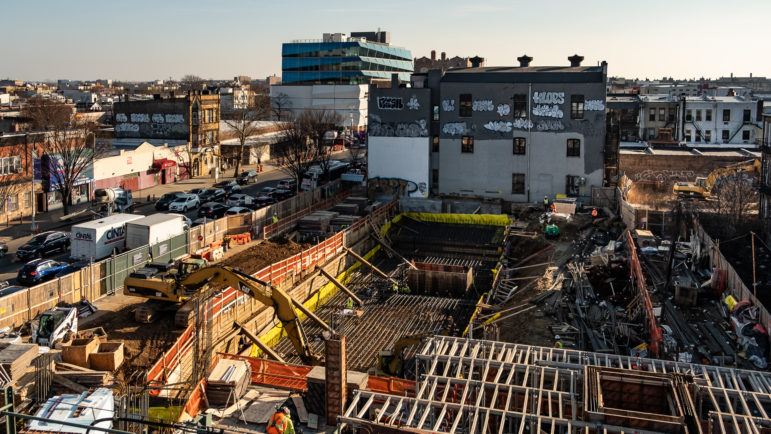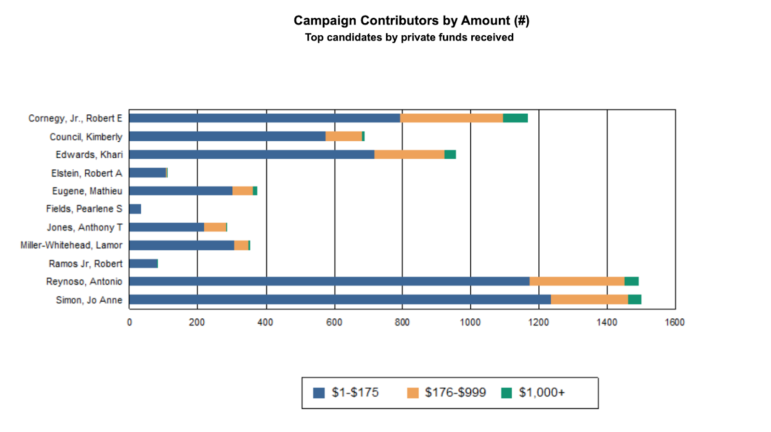Weeks ahead of the June 22 primary, some of the largest donations in the race have come from real estate developers, a City Limits analysis of campaign finance records found. The contributions come at a hotpoint for the quickly developing borough, a moment where anti-development sentiment remains high, and recent city zoning plans have drawn criticism.

Adi Talwar
An affordable housing development site in East New York in 2020.Democratic contenders for Brooklyn borough president have raised more than $1 million in the race to replace Eric Adams, city campaign finance records show.
As of early May, term-limited Brooklyn Councilmember Robert Cornegy led the slate of 12 Democrats vying for the seat with more than $306,500 raised, followed by Assemblymember Jo Anne Simon, who has received more than $223,200. Antonio Reynoso, the Council member representing Williamsburg and Bushwick, came in third with around $210,000 in contributions.
Weeks ahead of the June 22 primary, some of the largest donations in the race have come from real estate developers, a City Limits analysis of campaign finance records shows.
Of the top 10 donations to Democratic candidates so far, all but one came from a donor outside of Brooklyn. That in-district contribution was from Simon — who represents north Brooklyn neighborhoods like Boerum Hill, Cobble Hill, and Park Slope — toward her own campaign. Seven of the top 10 contributions came from outside the city entirely.
Minus Simon’s contribution to herself, the remainder of the top 10 donations went to Cornegy, records show. These include contributions from the president of a chain of grocery stores and a few developers, including George Tsunis of Chartwell Hotels. Tsunis’ wife, Olga, also contributed to Cornegy’s campaign.
While Cornegy has pulled in the biggest fundraising haul overall, both Simon and Reynoso have outpaced him in terms of total number of donations received, with a majority of their contributions coming in at smaller amounts (between $1-$175), records show.

The election comes at a hotpoint for the quickly developing borough, a moment where anti-development sentiment remains high and recent city zoning plans have drawn criticism.
“For the past almost decade, Brooklyn has led in terms of housing development,” said Christopher Walter, land use policy coordinator at the non-profit Association for Neighborhood and Housing Development.
Even in 2020, when the pandemic slowed construction projects across the five boroughs, 43 percent of new housing completions happened in Brooklyn, according to the Department of City Planning.
Some candidates for Brooklyn BP, like Reynoso and Simon, say they have rejected developer dollars in their campaigns, they told City Limits.
“I haven’t taken a dollar from developers, and if I find one, I return it quickly,” Reynoso, who has positioned himself as one of the most progressive candidates in the race. Public Advocate Jumaane Williams has endorsed him, as has state Sen. Jessica Ramos.
Perception is important, said Simon, who represents neighborhoods including Boerum Hill, Park Slope, Carroll Gardens and Gowanus, the proposed site of a contentious city rezoning plan.
“I have never taken developer dollars, because it is too easy for there to be at least an appearance of conflict,” Simon said.
Rev. Kim Council, former president of the East New York Housing Development Corporation, who has raised just over $83,900, has refused for-profit developer money, she told City Limits.
“You don’t want to sweep developers with the same brush,” she said. “But you want to make sure that before you get into office that you’re not beholden to any group of people.”
At least $30,780 — or about 10 percent — of Cornegy’s contributions come from those identifying themselves as working in real estate, including developers and investors, the City Limits analysis found. City Limits’ calculation of real estate donations includes those working in the field who described themselves as “real estate,” “developer,” “investor,” and “property management,” among other titles. It does not include those who may be working in the field who describe themselves using titles like “president” or “chief executive.”
Cornegy said in a statement that he if he is elected, he would be “unapologetic and unflinching” in demanding more public benefits from developers.
“We cannot reflexively say no to every proposal,” he added.
“The anti-real-estate movement pushes away developers when we need them at the table,” Cornegy said. “I plan to call a developers summit in the first quarter of my term as Brooklyn Borough President in order to spell out what I expect this community partnership to look like. As opposed to denying folks a voice, I welcome all to my table provided that they are for Brooklyn — and can prove it.”
On the big issues
Affordable housing, particularly for families, was a major priority for borough president candidates who spoke with City Limits (City Limits sent inquiries to each Democratic candidate in the race, though several had not responded as of press time).
“I worked alongside union members with great benefits, great pensions who were actually living in their cars or living in homeless shelters because they didn’t earn enough to live in the borough,” said candidate Khari Edwards, a former executive at Brookdale Hospital.
A major part of the problem, Edwards and other candidates said, is that federal affordability formulas use an area median income metric (AMI) that is skewed because it includes counties outside the city. As a result, those who need affordable housing the most often don’t get it, he said.
“We know that what is considered affordable right now is not affordable,” said Council. “The average median income for the entire borough of Brooklyn is $34,000. The current formula that they’re using takes the five boroughs and Westchester and skews it up to between $62,000 and $72,000. Which means that the average person that lives in Brooklyn cannot afford what is affordable.”
Borough presidents can also use the bully pulpit and advocate for more federal investment in housing, which could fund programs like Mitchell-Lama, or public housing systems like NYCHA, Simon said. Not-for-profit developers struggle to get bonding and access to capital, things that private developers have fewer difficulties securing.
“That [federal investment] will make it possible for us to resurrect something like Mitchell-Lama,” Simon said.
Land use and rezonings
Many candidates also expressed a willingness to work with other officials to change the city’s Uniform Land Use Review Procedure, or ULURP, the process of reviewing and approving land use changes across New York City.
While the borough president has only an advisory vote on projects under ULURP, not a binding one, some candidates said they wanted to work to change the process and further engage community members.
“ULURP reform is definitely the most important thing for us right now,” said Reynoso. “The current process that exists is a developer-first, developer-driven process that alienates a lot of these communities, especially these Black and brown communities.”
Reynoso’s plan calls for working with community boards to determine development needs.
“Instead of having this piecemeal approach where one or two communities in the borough are building all the affordable housing, we ask everybody to be a part of it — Canarsie, Midwood, Bay Ridge, all of them. We can give that as a foundation to developers, so they know where the opportunity areas are for development.”
In its current form, ULURP also isn’t exactly tailored to a community’s unique needs, said Assemblymember Simon.
“One of the things that I find the most frustrating and the most destructive about ULURP is the fact that it essentially sets people up to take sides in a yes or no way that is fundamentally unhelpful to what our real development needs are and what the needs of the people of the city of New York — and especially Brooklyn — need,” Simon said.
The Gowanus rezoning, currently planned in her district, is one of those that raises these problems, she said. The city is proposing to rezone a large section of the neighborhood to facilitate the construction of more housing, which officials say would add approximately 8,500 new apartments, including 3,000 affordable units.
Concern over ULURP is part of what prompted Robert Elstein, a teacher who lives in Flatbush, to run for borough president. Though he is not among the leading candidates in terms of fundraising, the fifth-generation Brooklynite was motivated to run after working unsuccessfully with his neighbors to stop a local upzoning.
“I was inspired by a group of my neighbors called Save Cortelyou that were fighting against an upzoning through the ULURP process, which ended up being unsuccessful on our part. Through that work I was kind of awakened to the corruption that exists in the ULURP process,” Elstein said.
Cornegy says he wants to “depoliticize” ULURP by “requiring that projects demonstrate, among other targets, neighborhood-based affordability and a solid plan for local jobs with a defined outreach plan.”
He hopes to have planning experts work with community boards to assist in their understanding of zoning, and wants to introduce a proposal via the Brooklyn delegation to restructure the City Planning Board, so that two of the board’s 13 members will be voted in by community board chairs or committee members.








